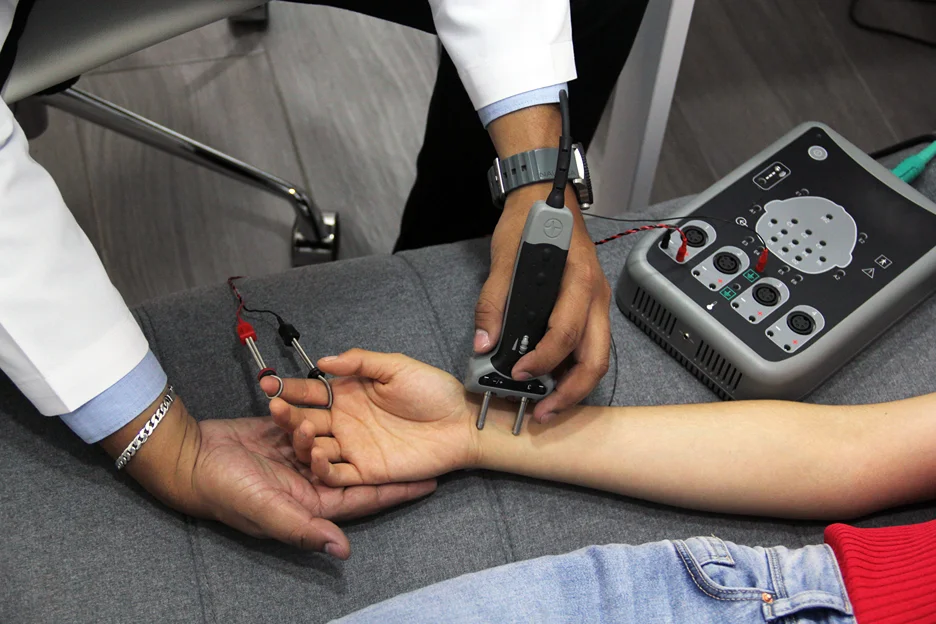Pulsating Neck Pain: Causes, Symptoms, and Treatments
Have you ever woken up with a stiff neck, only to have the pain linger for days? Or noticed a throbbing, pulsating discomfort on the right side of your neck when checking your pulse or swallowing?
While occasional neck pain from sleeping in an awkward position is normal, chronic or worsening pain over the carotid pulse can indicate an underlying condition that requires medical attention.
What’s Causing the Pain on the Right Side of Your Neck?
Neck pain can stem from numerous sources, ranging from muscle tension to vascular problems. Understanding the potential causes can help you determine when to seek treatment.
Muscle Strain in the Neck
The neck contains many small muscles that support the head and allow flexibility. Overuse or injury to these muscles can cause localized pain:
| Muscle | Description |
| Sternocleidomastoid | This thick muscle running down both sides of the neck is commonly involved in neck strains. Poor posture like hunching over a computer stresses the SCM. |
| Scalene muscles | These muscles at the sides of the neck become tense from injury or poor posture. Scalene strain creates a nagging, throbbing pain. |
| Trapezius | The trapezius muscle extending from the upper back to the neck and shoulder blade can develop chronic knots, leading to neck and shoulder pain. |
Acute muscle strains or spasms in the neck typically cause a constant dull, achy feeling made worse by certain motions like turning the head or swallowing. Applying heat, massage, and taking anti-inflammatory medication can help relax the tensed muscles.
Spinal Conditions Affecting the Neck
Problems with the cervical vertebrae, discs, or nerves in the neck region also frequently contribute to neck pain:
| Condition | Description |
| Cervical spondylosis | Age-related wear and tear causes bony protrusions from the vertebrae that press on nerves, resulting in pain down the arm or side of the neck. |
| Herniated cervical disc | A ruptured or bulging disc in the neck region can pinch nearby nerves, causing severe neck pain and numbness. |
| Cervical radiculopathy | Irritation of a cervical nerve root, often from pressure by a herniated disc or bone spur, results in sharp neck pain radiating down the arm. |
| Cervical spinal stenosis | Narrowing of the spinal canal puts pressure on the spinal cord and nerves, leading to numbness, tingling, and debilitating neck pain. |
For spinal-related neck pain, options range from physical therapy exercises to steroid injections or surgery for severe cases not responding to conservative treatment.
Vascular Causes of Neck Pain
Less commonly, pain on the right side of the neck over the pulse can signal a vascular origin:
| Condition | Description |
| Carotidynia | Inflammation of the carotid artery can cause tenderness and pain over the artery. This condition is often self-limiting but can cause significant discomfort. |
| Carotid artery issues | Blockage from plaque buildup, inflammation, or damage to the carotid artery on the right side of the neck restricts blood flow. This can produce localized pain over the artery. |
| Jugular vein problems | Clots in the jugular vein or phlebitis causes swelling and tenderness along the vein running down the right side of the neck. |
| Other arterial or venous disorders | Vasculitis, an autoimmune condition causing inflamed blood vessels, can also lead to throbbing unilateral neck pain. |
Vascular testing like CT angiography or ultrasound helps diagnose blood vessel issues. Treating the underlying condition improves the neck pain, and surgery may be required for certain arterial blockages.
Recognizing Symptoms of Neck Pain Over the Pulse
Familiarizing yourself with the characteristic symptoms of pain on the right side of the neck over the carotid pulse helps determine when to seek medical care.
Nature of the Pain
- Sharp, stabbing pain that feels like pins and needles in the right neck suggests nerve root compression from a herniated disc or spinal stenosis.
- Dull, achy discomfort that worsens when turning the neck often indicates muscle tightness or strain.
- Throbbing or pulsating pain over the right carotid artery may signal vascular problems impairing blood flow.
Pain Triggers
- Neck pain when swallowing or chewing can result from muscle tension or joint arthritis involving the cervical spine.
- Discomfort triggered by sudden neck movements points to muscle or ligament sprains.
- Pain when touching the right side of the neck indicates localized injury or nerve irritation.
Associated Symptoms
- Headache, dizziness, ringing in the ears, and vision changes with neck pain can indicate poor circulation from carotid blockages.
- Numbness or tingling radiating down one arm suggests cervical radiculopathy from a herniated disc or spinal stenosis.
- Difficulty speaking or swallowing may occur if the pain involves nerves to the larynx or esophagus.
Consulting a Doctor for Neck Pain Over the Pulse
Seeking timely medical care helps determine the cause of throbbing neck pain over the carotid pulse and prevents complications. You should schedule an urgent doctor visit if:
- Neck pain arises suddenly or reaches excruciating levels.
- Headache, fainting, or vision changes accompany the neck pain.
- You have a history of stroke, vasculitis, or blockages in the carotid arteries.
- Discomfort persists for over 1 week despite rest, heat, and pain medication.
- Swallowing, shoulder/arm movement, or coordination worsens.
- Numbness, weakness, or tingling develops in the arms or face.
Severe neck pain associated with symptoms like arm numbness or vision issues requires prompt emergency care to rule out vascular catastrophes like stroke or carotid dissection.
Diagnosing the Underlying Cause of Neck Pain over the Pulse

Doctors use various diagnostic approaches to pinpoint the reason for localized neck pain over the carotid artery:
Physical Examination
Your physician will palpate the sore area to check for tenderness, swelling, or muscle tension, and assess neck mobility. Neurological tests help evaluate muscle strength, reflexes, and sensations to look for nerve involvement.
Medical History Review
Your doctor will ask about risk factors like smoking, heart disease, and prior neck injury. Details about the pain onset, triggers, and associated symptoms help narrow down the cause.
Imaging Studies
- X-rays and CT scans identify bone spurs and narrowing in the cervical spine pointing to spondylosis or spinal stenosis.
- MRI scans clearly visualize cervical discs, nerve roots, and soft tissues around the carotids to pinpoint the pain origin.
- CT angiography examines blockages in the carotid arteries and integrity of neck vasculature.
- Ultrasound allows dynamic visualization of blood flow in the carotid arteries and jugular veins.
Blood Tests
Nerve Testing
Electromyography checks for nerve damage in the neck, and nerve conduction velocity assesses signal transmission in cervical nerves.
How to Treat Pain on the Right Side of the Neck Over the Pulse
Treatment targets the specific cause of neck pain uncovered during the diagnostic workup:
Muscle Strain Relief
Gentle neck stretches, heat/ice therapy, OTC pain medication, and massage can relax strained sternocleidomastoid or scalene muscles causing a constant ache.
Spinal Condition Management
Cervical disc herniations or bone spurs require physical therapy, epidural steroid injections, or possible spine surgery if conservative measures fail.
Vascular Disorder Treatment
Carotid artery blockages may need revascularization procedures like endarterectomy or stenting to improve blood flow, along with medications to prevent clotting. Underlying vasculitis requires immunosuppressants.
When to Consult a Medical Professional
In most cases, neck pain eases within a few days with self-care. However, worsening pain on the right side by the carotid pulse, especially if accompanied by neurological symptoms like numbness or weakness, warrants prompt medical evaluation.
Early intervention prevents permanent nerve damage or stroke risk from a vascular disorder or spinal issue involving the cervical vertebrae or nerves. While frustrating, neck pain serves as an important warning sign to take seriously.
Exploring Alternative Treatments for Neck Pain Over the Carotid Pulse
In addition to traditional medical treatment, some alternative therapies may provide pain relief and promote healing for discomfort on the right side of the neck over the carotid pulse area.
Chiropractic Care
Chiropractors use spinal manipulations and neck adjustments to improve mobility of the cervical vertebrae and correct posture issues that can contribute to neck pain. Studies show chiropractic treatment effective for certain types of neck pain.
Acupuncture
Acupuncture involves inserting thin needles into specific points on the neck and back to reduce pain signals and improve blood circulation. This traditional Chinese medicine approach may help temporarily relieve chronic neck pain when performed by an experienced practitioner.
Massage Therapy
Various massage techniques can loosen tense neck muscles, reduce trigger points, and increase range of motion in the area of neck pain. However, deep tissue massage should be avoided over the carotid pulse if a vascular disorder is suspected.
Pillows and Posture Support
Special contour pillows properly align the head, neck, and shoulders during sleep. Posture braces also encourage upright positioning during daily activities to prevent neck strain.
Stress Management
Chronic stress causes muscle tension that can exacerbate neck discomfort. Relaxation techniques like yoga, meditation, biofeedback, and guided imagery help control the pain response.
Transcutaneous Electrical Nerve Stimulation
TENS units deliver small electrical impulses through surface electrodes placed along the right side of the neck to disrupt pain signals and encourage endorphin release. Evidence for TENS efficacy is limited but it poses little risk.
Topical Analgesics
Over-the-counter creams containing menthol, capsaicin, camphor, or other analgesics can provide temporary numbing and pain relief when applied to the sore neck area. This avoids potential side effects of oral medication.
When Neck Pain Over the Carotid Pulse Requires Surgery
For severe carotid artery blockages or irreparable damage causing persistent neck pain, surgery may become necessary as a last resort when more conservative measures fail.
Carotid Endarterectomy
This procedure involves opening the carotid artery and surgically removing plaque buildup to improve blood flow. It’s done under general anesthesia with a short hospital stay afterwards. Full recovery takes around 2 weeks.
Carotid Artery Stenting
Stenting is a minimally invasive option that inserts a mesh tube called a stent into the carotid artery to widen it from the inside without surgery. Recovery is faster than with endarterectomy but has a higher stroke risk.
Bypass Surgery
If the carotid artery is too damaged, a graft using a vein from the leg may bypass the diseased portion. This is more involved than endarterectomy or stenting and generally avoided unless absolutely necessary.
Aspirin and Anti-clotting Medication
These drugs will be prescribed long-term after carotid surgery to prevent blood clots that could lead to stroke. Strictly following medication instructions is crucial for maintaining surgical benefits.
Physical Therapy
Post-surgical physical therapy helps regain neck mobility and reinforce proper head/neck positioning. This facilitates complete recovery and reduces risk of pain recurrence.
Learning to Live with Chronic Neck Pain over the Carotid Pulse
For those with irreparable damage causing intractable neck pain not resolved by surgery, adapting daily habits can make the discomfort more manageable long-term.
- Take prescribed pain medication on schedule to maintain therapeutic levels.
- Apply heating pads or menthol creams to temporarily ease localized pain.
- Avoid hunching over phones/computers and carrying heavy bags that strain the neck.
- Sleep on a cervical pillow and use rolled towels for added neck support.
- Practice careful stretches and exercises to improve neck mobility.
- Reduce stress through yoga, meditation, massage, and other relaxation techniques.
- Stay positive and focused on activities you can enjoy despite the bothersome neck pain.
- Lean on friends and family for support during difficult days.
- See a pain specialist for additional therapeutic options to try.
- Weigh the risks and benefits of procedures like steroid injections or implanted nerve stimulators.
Coping with chronic neck discomfort can be discouraging. Staying proactive and utilizing all available treatment modalities provides the best chance for reclaiming one’s quality of life.
Experiencing Neck Pain Over the Pulse? Get Help Figuring Out Why

Ongoing pain or throbbing sensations on the right side of your neck where you can feel your pulse could indicate various underlying conditions: muscle strain, spinal issues, vascular disorders, and more. Pinpointing the exact cause is key for proper treatment.
Take control of your discomfort – schedule a visit with a neck pain specialist on Kaly today.
